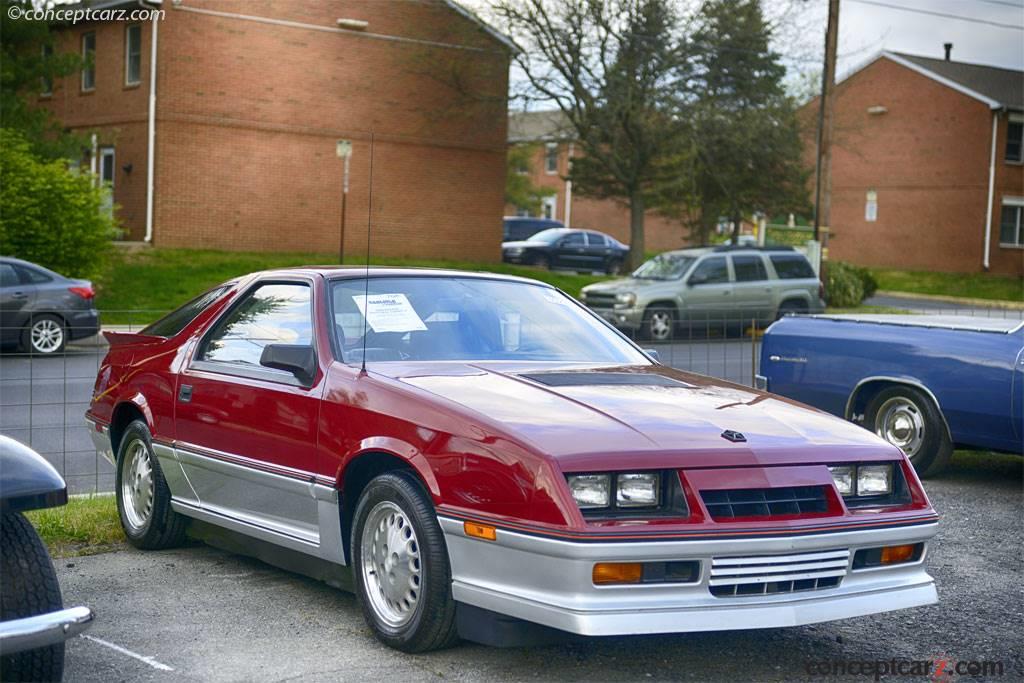Dodge introduced the Daytona in 1984 and it would remain part of the lineup through 1993, produced alongside the similarly-styled and more upscale Chrysler Laser (produced from 1984 to 1986 and billed as the Chrysler brand's first sports car). The front-engine, front-wheel-drive hatchback was based on the Chrysler G platform, which was derived from the Chrysler K platform. Power was initially sourced from the 2.2-liter Chrysler K engine in either a turbocharged or naturally aspirated configuration. The styling was sleek, aerodynamic, and low-slung. It had a large rear hatchback, a rear deck-lid spoiler, and a drag coefficient of 0.35. The Dodge Daytona rested on a 97-inch wheelbase platform which was slightly larger than the 96.6-inch wheelbase of the Charger and the 99.1-inch wheelbase of the Omni. The 135 cubic-inch four-cylinder engine was installed in the Daytona, 600 Sedan, Shelby Charger, Aires, and Charger in various configurations. It was also optional on the Omni. The 600 sedan and Daytona used the electronic fuel injection version which delivered 99 horsepower at 5,600 RPM and 121 lb-ft of torque at 3,200 RPM. With the help of a turbocharger, output rose to 142 bhp at 5,600 RPM and torque to 160 lb-ft at 3,200 RPM. The engine was backed by a close-ratio five-speed manual transmission and stopping power was by disc brakes in the front and drums at the rear. The Daytona represented Dodge's first turbocharged front-wheel-drive vehicle, and its improved performance did not sacrifice fuel economy, still delivering an EPA mileage estimate of 22 mph and 35 on the highway. The turbocharged system was developed by Garrett AIResearch and delivered 75 psi maximum boost and included a water-cooled turbine end-shaft bearing. They used a detonation sensor and could operate on no-lead regular gasoline, although factory literature recommended premium fuel. Additional improvements to the engine included dish-top pistons, an 8.0:1 compression ratio, an improved camshaft, a larger oil pump, tighter internal sealing, and a low-restriction exhaust system. With the turbocharger installed (RPO AGT), the list of standard equipment included 60-series 15-inch Goodyear Eagle GT tires, aluminum wheels, performance seats, gas-filled shocks, higher spring rates, larger stabilizer bars, and a performance handling package. The interior received Turbo dashes with analog gauges, and turbo seats with inflatable lumbar/thigh support bolster. The Turbo Z (RPO AGS) added two-tone paint and a deep airdam, tape stripes, bodyside moldings, ground-effects rocker extensions, and a unique rear spoiler. 
Coupe
Chassis #: 1B3BA64EXEG209132
View info and history
Auction entries : 1All Dodge Daytona models came with bucket seats in the front and rear, and a center console. The non-turbo Daytona hatchback had a base price of $8,300 and the turbocharged version listed for 10,227. Dodge produced 21,916 examples of the naturally aspirated version and 27,431 examples with the turbocharger for its inaugural year on the market.
by Daniel Vaughan | Apr 2021

Coupe
Chassis #: 1B3BA64EXEG209132
View info and history
Auction entries : 1
by Daniel Vaughan | Apr 2021
Related Reading : Dodge Daytona History
Production of the Daytona lasted from 1984 through 1993, and was sold by both Dodge and Chrysler. The Chrysler version, also called the Laser, was the upscale version. The Chrysler version was produced from 1984 through 1986 the Laser name would re-appear in 1989 and 1990 on the Plymouth. Both the Daytona and Laser were intended to replace the Chrysler Conquest. For Chrysler, the Laser had additional....
Continue Reading >>
Continue Reading >>
Similar Vehicles
Similarly Sized Vehicles
from 1984
Dodge Monthly Sales Volume
March 2023
50,975
1984 Dodge Daytona Turbo Vehicle Profiles
Recent Vehicle Additions
Performance and Specification Comparison
Price Comparison
Daytona Specification Comparison by Year
Year
Production
Wheelbase
Engine
Prices
97.00 in.
4 cyl., 97.58 CID., 102.00hp
4 cyl., 135.00 CID., 142.00hp
4 cyl., 155.92 CID., 145.00hp
4 cyl., 135.00 CID., 142.00hp
4 cyl., 155.92 CID., 145.00hp
$10,225 - $10,225
Related Automotive News

100 Years Of Mazda |The Mazda RX-7
Launched in 1978, the definitive rotary sports car become a cult classic across three generations.
Won on the race track and rally stage across the globe, including the 1980 and 1981 BTCC titles.
Redefined rotary-powered driving fun and unique Maz...

INTRODUCTION OF NEW 1.4T ENGINE REINFORCES VOLKSWAGEN'S LEADERSHIP IN TURBOCHARGED, DIRECT INJECTION TECHNOLOGY
Fitment of EA211 engine in Jetta models extends implementation of intelligent downsizing to 97 percent of Volkswagen vehicles sold in the U.S. market
Traverse City, MI — Volkswagen pioneered the use of small displacement highly efficie...

2016 CHEVROLET CRUZE FEATURES NEW ECOTEC ENGINES
New engine family, 6T35 transmission balance power, efficiency and refinement
DETROIT – The 2016 Chevrolet Cruze is powered by General Motors new, global family of Ecotec small-displacement engines, featuring a modular architecture that...

VOLKSWAGEN CELEBRATES 40 YEARS OF THE GOLF AT THE NEW YORK AUTO SHOW
The most successful European car of all time turns 40
More than 30 million Golf models have been sold worldwide
Car went on sale in Europe in May 1974, was sold in the U.S. from December that year as the Rabbit
Seventh-generation Golf GTI goes on...

Squaring the circle: even more efficient and even cleaner – the new Fuso Canter with Ecofficiency
Ecofficiency the Canter is both cleaner and more economical
Engine 2000 bar injection pressure boosts efficiency
Longer axle ratios reduce fuel consumption
Emission control optimised for different weight categories
ESP as standard for all mode...












